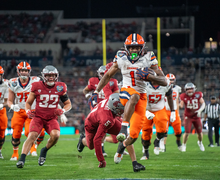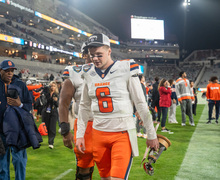Bone to pick: Student works with 100-year-old samples from the Smithsonian
Frankie Prijatel | Senior Staff Photographer
Soleil Young decided very early on in her SU career that she wanted to add anthropology as a complement to her biology one.
For Soleil Young, a senior biology and anthropology major, physical appearance, general interests and academia all seamlessly blend into each other.
She is an intersection of fashion, biology, activism and anthropology. She wears thick, black-framed pointy glasses, a septum ring, a beanie and a denim dress donned with a large Remembrance Scholar pin.
“She has a real talent for crossing boundaries and disciplines,” said Shannon Novak, an associate professor of anthropology at Syracuse University. “She clearly comes at topics from a very diverse — humanistic, scientific and activist — background. It’s really impressive.”
Young’s latest scientific efforts are rather niche. For her anthropology honors thesis, she scrapes bone dental calculus — a form of hardened dental plaque — to extract DNA for research and signs of tuberculosis. Her samples come from the Smithsonian Institution in Washington, D.C.
She hopes to finish molecular study of the calculus by the end of November and then wants to focus on the historical and social context behind it throughout the rest of the year.
Novak, who helped Young with her proposal for the Smithsonian, said Young has been in all of her classes and has always had an interesting take on a topic that others may not bring up.

Frankie Prijatel | Senior Staff Photographer
Over the summer, Young received seven samples from the Smithsonian to run a pilot test of TB in dental calculus, which is the mineralized plaque from calcium phosphate. The process traps DNA and adheres to the teeth, so calculus cannot be removed by brushing.
When Young finished her pilot study with the seven samples, she wrote her proposal to the Smithsonian, and it was approved.
“It was really scary in the beginning because I had no idea if it was going to work or not,” Young said. “I kind of convinced myself it wasn’t going to work. There’s a lot of factors when you’re just working with regular samples that are problematic, but when you’re working with ancient DNA, it’s like a lot of unknowns.”
She knew there has been a lot of work in using dental calculus for research. There have also been a lot of procedures in finding tuberculosis in DNA, but Young decided to try combining the two methods into this new one for her honors thesis.
Last week, Young visited private access areas of the Smithsonian to retrieve six particular individuals’ samples from the Institute’s Huntington collection to carry out her dental calculus molecular theories in tracing TB. These bodies are from the 1892-1920 timeframe in New York City.
Young said an 1854 law called the “Bone Bill” applies to this collection, because grave-robbing was a large problem. The bill stated that individuals who died in almshouses — which housed poor people — or hospitals and did not have the funds for burials would have their bodies donated to medical collections.
The Huntington collection at the Smithsonian is composed mostly of marginalized ethnic groups or immigrant groups because those were most often the people whose families didn’t have enough money to bury them.
Young’s samples come from the Huntington collection’s six Irish-Americans bodies that still had teeth.
“You’d be surprised by how many skeletons don’t have teeth,” she said.
She added that although TB is not very common in the United States, it is the leading infectious disease worldwide, and multidrug-resistant tuberculosis is evolving rapidly. So the TB bacteria are combating antibiotics and will be able to overcome modern medicine.
“It’s going to become a huge issue in the foreseeable future, and it’s very hard and expensive to treat,” she said. “We’re trying to say that being able to study the genetics of TB across larger timespans can give a greater understanding of its evolution, which is applicable in modern health today.”

Frankie Prijatel | Senior Staff Photographer
Typically, scientists study TB in bones through lesions that are left on the rib, but Young said only about 10 percent of people with TB will have developed bone lesions. Another problem is that ribs are sometimes missing from collections for a variety of reasons.
Young said her molecular biology study on the dental calculus is an easier way to study TB, because, unlike other methods, it does not ruin the integrity of the bone. The worry of ruining the integrity of bones is why researchers are usually hesitant in using bones for new sample studies, she added.
From a very young age, Young knew she liked the study of bones. She said she enjoyed visiting a cemetery in Madison, Wisconsin, as a child. In high school while living in Syracuse, she started doing work in SU’s Garza Lab, part of the SU department of biology.
From there, Young immediately knew that she wanted to double major in biology and anthropology. Through the Garza Lab, she met Jessica Comstock, a Ph.D. candidate in biology. Young frequently goes to Comstock for advice in sequencing DNA and lab studies.
“Soleil is a driver in crafting her own interests, for sure,” Comstock said. “That’s something I’ve been impressed by: finding a way to integrate all of her interests into this project. That is rare, especially at the undergrad stage.”
Young’s work in the lab with Comstock is how she met another Ph.D. candidate biology student: Caitlin McDonough. McDonough said she enjoys Young’s presence in the lab, along with her wealth of esoteric knowledge. She described Young as “positive in a spooky, dark way.”
This spooky attitude is something Young shares proudly. She is a fan of “The X-Files” and enjoys working with teeth, but said she would not want to work as a dentist.
“I would never want to work with people who are alive,” Young said. “I like to work with the dead.”
Published on November 1, 2016 at 8:25 pm





